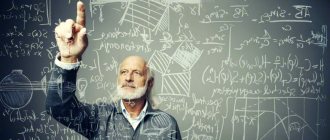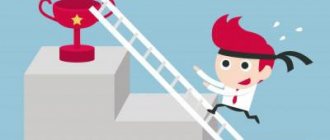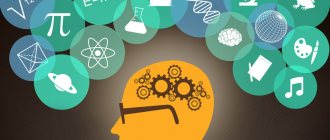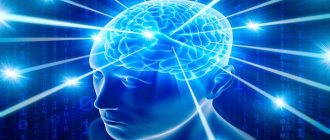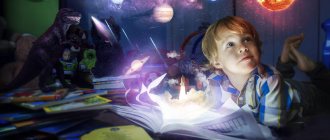One of the features that distinguishes a person from an animal is his ability, when coming into contact with the world around him, to observe, influence it, transform and create something new.
Moreover, often a person acts not limited by the framework of reality, but guided by his imaginary ideas. We will consider the mechanisms of imagination in psychology in this article.
Generally accepted concept
Imagination is a cognitive process used in mental functioning and sometimes in combination with psychological imagery. It involves thinking about possibilities in the future.
Imagination helps every person to convey his idea of the world around him. This is a human ability that allows you to transmit information in the form of images
A related term, "mental imagery", can be used in psychology to refer to the process of recalling memory. Memories of objects previously represented in sensory perception.
Because the use of this term conflicts with the use of ordinary language, some psychologists prefer to describe this process as "imagination" or "imaging", or to call it "reproductive" rather than "productive" or "constructive" imagination.
What types of imagination are there?
Imagination also gives us the ability to see things from other perspectives and empathize with others. It expands our experiences and thoughts, allowing us to create our own worldview, which reduces our feelings of uncertainty.
In this way, our imagination fills in gaps in knowledge, allowing us to create mental maps that help us get out of difficult situations in life. Our brains use different types of imagination at different times in our lives.
The imaginary world that a person imagines is part of our representation of real events and material objects. There are several types of imagination
Passive
Passive imagination is the creation of certain images that are initially perceived by a person as unreal.
It also creates images in special personality states when a person does not control the process of creating these images.
Most often it is based on fears or desires that are considered feasible in the process of fantasy;
2.Active
This is how we fantasize if we ourselves want to. This kind of imagination can be seen in the work of designers or writers. We purposefully create images in our heads.
Most often, this form manifests itself in creative activities not only among professionals, but also, for example, in children's role-playing games;
3.Creative
Creative imagination is one of the varieties of active imagination. Its difference is that it usually has practical benefits and value for other people or society as a whole.
Imagination helps a person to manifest his thoughts, desires and dreams. For creative people, imagination plays a huge role in their life journey.
For example, after looking at a graph with the latest equipment, we will already have an idea of what it is and what functions it performs. Coming up with something of your own using only creative imagination is quite difficult;
4.Free
Voluntary imagination is also a type of active imagination. This type differs from the previous ones in that at the moment of action a person is aware of the goals and motives for creating the image.
An example of this type of imagination is a situation when a person thinks about something that most likely will not come true or the likelihood of this happening is negligible;
5. Recreating
Recreating imagination is the creation of images of objects by a person that were not previously perceived by him in their entirety.
Images are created from descriptions in words, pictures, drawings, maps of any area. Our imagination recreates what happened in our heads and fills in the gaps thanks to this form of imagination.
So, we have looked at the most famous types of fantasies, which fully reveal the essence of the imagined consequences and the principles of their action.
Imagination and creativity
Creativity is the process of creating fundamentally new or improved methods for solving tasks and problems. It becomes obvious that imagination and the creative process are very interconnected.
Imagination here is defined as the transformation of ideas about reality and the creation of new images on this basis. It works every time a person thinks about some object or phenomenon, without even coming into direct contact with it. Thanks to creative imagination, the transformation of this idea is carried out.
Creative thinking and imagination have their own specific characteristics. Through this process, it is possible to create completely new, unique representations based on the subject's own ideas and thoughts, which express the personality of the creator. It can be voluntary or involuntary. To a large extent, creative imagination or inclination towards it is determined from birth, but it can also be developed.
The development of creative imagination occurs in three stages. At first, a creative idea arises. In the mind of the creator, a fuzzy image first appears, an initial idea that can be created arbitrarily, without purposeful comprehension of the idea. The second stage involves hatching a plan. A person thinks about strategies for translating an idea into reality and mentally improves it. The third stage completes the incubation of the idea and brings it to life.
The development of creative imagination is carried out in the process of transition from involuntary to voluntary, from recreating to creative. During childhood and adolescence, creative imagination has characteristic features; it is special for its magic, fantastic judgments about the world and the absence of a critical component of thinking and rationality. During adolescence, complex changes occur in the body, and therefore in consciousness as well. Objectivity is developed, perception becomes more critical. Rationality of perception appears a little later, when a person becomes an adult. The adult mind begins to control the imagination, often too much criticality and practicality weakens the processes of fantasy, overfilling them with meaning, loading them with some kind of information that is actually unnecessary.
There are certain methods for developing creative thinking. The most practical method is to read literature and watch scientific films, expand the range of your knowledge, draw knowledge from different areas of life, memorize and analyze information. In this case, a large amount of materials for creative processes appears.
Imagine imaginary objects, try to carry out various manipulations with them. For example, imagine the sea, hear the sound of breaking waves, feel the breath of sea freshness, imagine entering the water, feel its temperature, and so on. Or another example, imagine a pear. Imagine its shape, size, color. Use tactile perception, imagine it when it is in your hand, feel its surface, aroma. You can mentally take a bite of it and imagine the taste.
In order for the imagination to be voluntary, it is necessary to work on it through regular training. To make the effect even greater, you need to look for sources of inspiration, ask friends for help, and ask about their ideas. Try group work to create ideas, sometimes the results are very unique, and a person becomes more active if the process of imagination occurs in a circle of other creative individuals.
Imagination in psychology
Psychologists believe that imagination is quite possibly a human ability. Essentially, it allows us to explore things that are not in our current environment or may not even exist.
Imagination can greatly change a person's consciousness. It is worth controlling your fantasies, as you can lose the line between the real and unreal world
For example, you might imagine a cup of coffee seen the day before, or you might imagine an alien spaceship arriving in Earth orbit.
The key point is that what is imagined is created from within, rather than perceived based on input from the outside. This is a great opportunity to create new technologies. After all, everything that has already been invented now on our planet may also have appeared from the imagination of people. This phenomenon especially develops in childhood.
Young children often invent various trinkets that they have never seen before and had no idea about their purpose. These creative abilities will define their entire lives. After all, the better the imagination is developed, the more roads into life a person can open for himself.
Properties of imagination as a psychological process
The uniqueness of imagination as a mental phenomenon is as follows:
- Imagination in its essence is a mental exit beyond the immediate perception of the individual;
- Imagination anticipates the future, contains a vision of the result of activity;
- Imagination allows you to “revive” what was earlier.
Too lazy to read?
Ask a question to the experts and get an answer within 15 minutes!
Ask a Question
Functions of the imagination
Fantasy and imagination play an important role in mental control. They are helping:
- Eliminate the problem of emotional overload associated with the fact that we are waiting for some situation. After all, the signs of this problem are partially eliminated by imagining this situation. Long-term wishes are satisfied and there is no longer strong anxiety;
- Another of its functions is associated with the regulation of other cognitive abilities - perception, memorization, understanding, speaking. Formed images (based on associations), associated with the search for the desired object in the environment, direct a person’s attention to objects that correspond to them;
- Reproducing a situation that has already happened in your head makes the search for speech means in a conversation faster. You conduct the conversation measuredly, without tension;
- Another function of imagination allows a person to plan his actions for the future, imagine his goal and plan for its implementation, understanding intentions and means in general;
- A figurative idea of a future frightening situation partially prepares a person for it psychologically and allows you to think through an action plan in advance in case of failure.
Thanks to imagination, we live our lives much easier, because thanks to it it is easier for us to control our emotions and suppress obsessive desires.
Mechanisms for creating images
Without imagination there would be no books and films
The images that arise in the imagination do not appear out of nowhere. They proceed from received ideas about real phenomena and objects.
Life impressions are combined in a person’s imagination, taking on various forms.
Imagination processes are divided into two levels:
- Analysis of impressions.
- Synthesis of the resulting images.
At the first level, ideas about an object are abstracted from other images, their components are separated, and analysis occurs. Subsequently, these images are transformed: combined into different combinations or reincarnated into completely new ideas.
This synthesizing process takes many forms. Agglutination is one of the common forms of synthesis, during which a new image is created by transferring the characteristics of one object to another.
In this way, images of ancient gods and mythical creatures were created in the imagination. The technique of agglutination is widely used in art and other creative processes.
For example, in order to draw a non-existent animal, it combined the features of various famous animals and birds. With the help of agglutination, parts of an object or the entire object are increased or decreased. This is how fairytale giants and gnomes were created.
By introducing existing ideas into new situations, new connections with completely different meanings are obtained. A person achieves correspondences in this combination by imagining the goal and controlling the process.
The synthesis of ideas is carried out through schematization and emphasis. Schematicization occurs as a result of insufficiently complete perception of the object. As a result, the holistic image may be distorted and inconsistent with reality.
Also, schematization can manifest itself when forgetting some properties of an object and representing it in a more generalized way. A person can consciously or unconsciously highlight certain features in an image.
Emphasis lies in focusing attention on the main properties of the image and creating a typical idea of the subject. In this complex creative process of generalization, a person identifies the main, in his opinion, features in the image and reflects reality through his own prism.
Forms of imagination
Imagination comes in several different forms. Let's take a quick look at the 3 most common forms, for example:
- Thought experiment . The cognitive process by which scientists sought to reflect actions that were ahead of reality;
- Fantasies . A form of imagination that is completely at odds with reality. As a rule, we cannot turn fantasies into reality. This happens because most fantasy objects do not exist in reality;
- Dream . Passive intentional form of imagination. In a dream, we see our emotional attitude towards the experience.
These are the most basic forms of imagination. They are quite enough to understand what imagination is.
Classification of imagination processes
According to the results:
- Reproductive imagination. (recreation of reality as it is)
- Productive (creative) imagination with relative novelty of images;
- with absolute novelty of images.
By degree of focus:
- active (voluntary) - includes reconstructive and creative imagination.
- passive (involuntary) - involves unintentional and unpredictable imagination.
By type of images:
- specific
- abstract
By methods of imagination:
- agglutination - the connection of objects that are not connected in reality;
- hyperbolization - increasing or decreasing an object and its parts;
- schematization - highlighting differences and identifying similarities;
- typification - highlighting the essential, repeating in homogeneous phenomena.
According to the degree of volitional effort:
- deliberate
- unintentional
Examples from life.
People often imagine. Waking up early in the morning, a person mentally chooses clothes, combining his things in his head.
After leaving home, we think about the shortest route to work or school, taking into account weather changes or other conditions.
After a hard day's work, we figure out what to cook from the available ingredients.
But it’s not only in everyday life that we use our imagination. For example, during a renovation, we mentally arrange the furniture around the room and imagine what the room will look like after the renovation.
When a person is alone with his thoughts, a great imagination is activated. Being alone, you can penetrate to a deep level of imagination and find answers to all the answers that interest you.
Physiological basis
Combinations of neural connections are formed at conscious and unconscious levels
Physiological processes responsible for the functioning of the imagination regulate the vital processes of the body.
Complex processes occur in the brain, during which nerve connections are activated and redistributed.
As a result of these processes, new neural combinations appear, which are the basis of the physiology of imagination.
Combinations of nerve connections are formed:
- at the unconscious level: from a spontaneous reaction in the cerebral cortex to various stimuli (for example, sleep or hallucinations);
- on a conscious level: in the process of a person’s independent creation of new images, several parts of the brain work (in all voluntary types of imagination).
The formation of new connections is not a random process; it can be described as the creative work of the brain.
Imagination influences many physiological processes: the functioning of organs, the level of activity of glands, metabolic processes. For example, when a person imagines a tasty dish, he salivates more.
When thinking about intense physical activity, you may notice subtle muscle activity. Consequently, imagination is closely related to human life processes and behavior.
Techniques for creating images
To create images, we use different techniques. For example, to diversify a literary text, writers often use hyperbolization. It is expressed in an increase in the size of an object or the number of its elements.
This technique is used to create multi-headed dragons or giants. The second most popular method of creating images is the addition. It lies in the fact that the hero of a fairy tale or any other work is assigned characteristics that are not characteristic of him. For example, a flying carpet.
Mechanisms of imagination
- agglutination - creating a new image from parts of other images
- hyperbolization - increasing or decreasing an object and its parts
- schematization - smoothing out differences between objects and identifying their similarities
- accentuation - emphasizing the features of objects
- typification - highlighting what is repeated and essential in homogeneous phenomena
There are conditions that contribute to finding a creative solution: observation, ease of combination, sensitivity to the manifestation of problems.
Guilford used the term “divergent thinking” instead of “imagination.” It means generating new ideas for the purpose of human self-expression. Characteristics of divergent thinking:
- fluency
- flexibility
- originality
- accuracy
Why does a person need imaginative thinking?
A person needs imaginative thinking for many reasons. Thanks to him, we can learn to find a way out of difficult life situations and solve difficult problems. Imaginative thinking helps us find calm and provides psychological protection from unnerving situations.
We can mentally transport ourselves to another place and catch our breath for a while. Some scientists believe that thinking about what might happen, especially in vivid colors, also increases the chances of dreams becoming reality.
Simple exercises to train your imagination
Development of thinking in an adult and a child - recommendations
Psychologists offer many simple but effective exercises for developing thinking and flights of imagination that are suitable for people of all ages. Their main advantages are simplicity and accessibility. Everyone is able to find in the flow of information the exercise that will appeal to a particular person. For example:
- Counting in your head is accessible and interesting to everyone who has school knowledge. There is no need to use any notes, just count mentally. The exercise is especially useful for those who are good at mathematics. You can fantasize about geometric shapes, mentally building all sorts of combinations from them.
- Paradoxically, you can watch children's cartoons with your child and use them as a workout for your mind and imagination. It's helpful to watch them without sound and then come up with funny dialogue. The funnier the better for the imagination.
- The simplest way relates to the world of books. Reading detective stories or fantasy is becoming fashionable; it will benefit both imagination and fantasy.
- “Nonsense piggy bank”, where you can put interesting things: thoughts, pictures, ditties, jokes - everything that is considered nonsense. If necessary, you can always get an idea for a creative solution from there.
- Collective games are becoming fashionable, then it’s time to get some old-time fun out of the box. For example, "Pantomime", in which players must guess what action is being depicted. Creative imagination develops based on memory, since you need to remember what picture the participants are depicting.
Simple exercises will help your imagination fly
Dream as a special form of imagination
A special form of imagination is a dream. When we dream, we create new images. But its difference from imagination is significant.
A dream is something that we would like to have. Dreams and flights of fancy are a powerful impetus to activity.
As a rule, it is real. While dreaming, we begin to build a plan of action to achieve it.
It is a certain goal that is currently unattainable, but with due diligence, it is quite possible that you will be able to fulfill it and achieve the desired result.
Voluntary and involuntary imagination
Home Favorites Random article Educational New additions Feedback FAQImagination is connected in various ways with the will of a person, on the basis of which voluntary and involuntary imagination are distinguished. If images are created when the activity of consciousness is weakened, the imagination is called involuntary . It occurs in a half-asleep state or during sleep, as well as in certain disorders of consciousness. Voluntary imagination is a conscious, directed activity, performing which a person is aware of its goals and motives. It is characterized by the deliberate creation of images. Active and free imagination can be combined in various ways. An example of voluntary passive imagination is daydreaming, when a person deliberately indulges in thoughts that are unlikely to ever come true. Voluntary active imagination manifests itself in a long, purposeful search for the desired image, which is typical, in particular, for the activities of writers, inventors, and artists.
Recreative and creative imagination
In connection with past experience, two types of imagination are distinguished: recreative and creative. Recreating imagination is the creation of images of objects that were not previously perceived in a complete form by a person, although he is familiar with similar objects or their individual elements. Images are formed according to a verbal description, a schematic image - a drawing, a picture, a geographical map. In this case, the knowledge available regarding these objects is used, which determines the predominantly reproductive nature of the created images. At the same time, they differ from memory representations in the greater variety, flexibility and dynamism of image elements. Creative imagination is the independent creation of new images that are embodied in original products of various types of activities with minimal indirect reliance on past experience.
Realistic imagination
Drawing various images in their imagination, people always evaluate the possibility of their implementation in reality. Realistic imagination occurs if a person believes in the reality and possibility of realizing the created images. If he does not see such a possibility, a fantastic imagination takes place. There is no hard line between realistic and fantastic imagination. There are many cases where an image born of a person’s fantasy as completely unrealistic (for example, the hyperboloid invented by A. N. Tolstoy) later became a reality. Fantastic imagination is present in children's role-playing games. It formed the basis of literary works of a certain genre - fairy tales, science fiction, “fantasy”.
With all the variety of types of imagination, they are characterized by a common function, which determines their main significance in human life - anticipation of the future , an ideal representation of the result of an activity before it is achieved. Other functions of the imagination are also associated with it - stimulating and planning. The images created in the imagination encourage and stimulate a person to realize them in specific actions. The transformative influence of imagination extends not only to a person’s future activity, but also to his past experience. Imagination promotes selectivity in its structuring and reproduction in accordance with the goals of the present and future. The creation of imaginative images is carried out through complex processes of processing actually perceived information and memory representations. Just as is the case in thinking, the main processes or operations of the imagination are analysis and synthesis. Through analysis, objects or ideas about them are divided into their component parts, and through synthesis, a holistic image of the object is rebuilt. But unlike thinking in the imagination, a person more freely handles the elements of objects, recreating new holistic images.
This is achieved through a set of processes specific to the imagination. The main ones are exaggeration (hyperbolization) and understatement of real-life objects or their parts (for example, creating images of a giant, genie or Thumbelina); accentuation - emphasizing or exaggerating real-life objects or their parts (for example, Pinocchio’s long nose, Malvina’s blue hair); agglutination - the combination of various, real-life parts and properties of objects in unusual combinations (for example, the creation of fictional images of a centaur, mermaid).
19.
Depending on the content of the activity, imagination is divided into technical, scientific, artistic and other varieties, determined by the nature of human work.
The artistic imagination has predominantly sensory (visual, auditory, tactile and other) images - very bright and detailed. Thus, I. Repin, painting the picture “The Cossacks write a letter to the Turkish Sultan,” wrote: “Their humor and noise make my head spin.” Flaubert said that he felt the sharp taste of arsenic in his mouth when he described the scene of Madame Bovary's suicide. Thanks to the brightness of sensual images, the artist and writer seem to directly perceive what is depicted in their works.
Technical imagination is characterized by the creation of images of spatial relationships in the form of geometric figures and structures, their easy dissociation and combination into new combinations, and imaginary transfer of them to different situations. Images of the technical imagination are often combined in drawings and diagrams, on the basis of which new machines and new objects are then created.
Scientific imagination finds its expression during the creation of hypotheses, conducting experiments, generalizations to create concepts. Fantasy plays an important role in planning scientific research, constructing an experimental situation, and predicting the course of the experiment. When building a scientific system, imagination is needed to complement the missing links in the chain of facts that have not yet been determined.
Fantasy is of great importance for the fruitful creative activity of a scientist. Without imagination, his work can turn into a pile of scientific facts, the accumulation of his own and others’ thoughts, rather than real progress in new inventions, ideas, and the creation of something fundamentally new in science.
A special form of imagination is a dream.
A dream is the process of a person creating images of the desired future. A dream is a necessary condition for the embodiment of creative ideas, when images of the imagination cannot be realized immediately for objective or subjective reasons. Under such circumstances, the dream becomes a real motivation, a motive for activity, thanks to which it becomes possible to complete the work begun. Without a dream, D.I. Pisarev noted, it would be impossible to understand what motivating force makes a person begin and complete extensive and tedious work in the field of art, science and practical life.
A dream is an element of scientific foresight, forecasting and activity planning. This function is convincingly manifested in artistic, creative activity, government, and social development. A striking illustration of this is the works of Jules Verne, in which he brilliantly foresaw the works of future technical thought - a submarine, a helicopter.
Dreams can be real, valid and unreal, fruitless. The effectiveness of a dream requires a condition for the embodiment of a person’s creative plans aimed at a real transformation of reality. Such dreams, in a certain sense, are the driving force behind a person’s actions and deeds, giving her more purpose in life, helping her fight difficulties and resist adverse influences.
Dreams can be empty, fruitless, “Manila”. Then they disorient a person, deprive him of a vision of real life prospects, push him onto the path of illusory satisfaction of his mental preferences, and make him unable to withstand the adversities of real life.
Only an active, creative dream has a positive impact on a person’s life; it enriches a person’s life, makes it brighter and more interesting.
Abilities are the psychological characteristics of a person that ensure success in activity and communication and the ease of mastering it. Let us pay attention to the most important aspects of this definition. This:
• individual characteristics, i.e., what distinguishes one person from another;
• not physiological (tall, long fingers, etc.), but psychological characteristics;
• not any individual psychological characteristics, but only those that correspond to the requirements of a certain activity, because there is no concept of abilities abstracted from the type of activity.
Consequently, abilities must always be assessed in connection with the activity, the process of mastering it and the results achieved.
Types and levels of abilities. Types of abilities according to their focus, or specialization, can be divided into general and special, theoretical and practical, educational, interpersonal and subject-related. General abilities are a prerequisite for the comprehensive development of the individual.
General abilities are understood as a system of individual psychological characteristics of a person, which explains the relative ease and productivity in mastering and carrying out various types of activities and communication. These are mental activity, a high level of analytical and synthetic activity, concentration, developed memory and speech, accuracy and subtlety of hand movements, high learning ability, efficiency, etc. In foreign psychology, these abilities are referred to as intelligens, which is equivalent to the expression “mental abilities” .
Special abilities are understood as a system of individual psychological characteristics of a person, which determines a person’s success in special types of activity and communication, where a special kind of inclinations and their development are necessary. These are linguistic, mathematical, technical, literary, stage, sports, musical, etc. abilities.
Theoretical abilities determine a person’s inclination to abstract logical thinking (theoretical scientists, philosophers), apractical abilities underlie the inclination to concrete practical actions.
Learning abilities influence the success of pedagogical influences, the formation of personality traits, and the acquisition of knowledge, skills and abilities.
Interpersonal abilities are the abilities to communicate and interact with people, and subject-related abilities are associated with the interaction of people with nature, technology, sign systems, artistic images, etc.
Inclinations are the capabilities with which a person is born. Without appropriate inclinations, the development of abilities is impossible, but the presence of inclinations is not always a guarantee that a person will demonstrate abilities. Inclinations are not ready-made abilities, but only an innate predisposition to their development, which can only manifest themselves under appropriate conditions; these are only possible future abilities.
Inclinations contain opportunities for the development of abilities in the process of training, education and work, but they do not contain abilities and do not guarantee their development; this is only one of the conditions for the formation of abilities.
Thus, the inclinations should be understood as the primary, natural basis of the ability, not yet developed, but making itself felt during the first attempts at activity.
Soviet psychologists (L.S. Vygotsky, A.N. Leontiev, S.L. Rubinstein) believed that motives and emotions, like mental and volitional processes, are formed throughout childhood, as a result of the child’s mastery of the experience of previous generations and the assimilation of developed a society of moral norms and ideals. As a result of such assimilation, the child acquires a unique system of standards of values, comparing observed phenomena with which he evaluates them emotionally as attractive or repulsive, as good or evil, as beautiful or ugly. Features of emotional development in infancy: - the basis for the development of emotions is made up of primitive emotions caused by organic reasons; - socially conditioned forms of emotional experiences are formed in the process of communication between an infant and adults; - in situational and personal communication, the child experiences joy from friendly attention to himself, dissatisfaction with the lack of communication; - in situational business communication, the child displays pleasure from joint manipulations, joy from successes and rewards, resentment and anger from reproach; - the prerequisites for higher feelings are formed - love and sympathy for loved ones. Features of emotional development at an early age: - emotional experiences are short-term, unstable, expressed violently, children are very impressionable, their behavior is impulsive, emotions act as motives for behavior; — further socialization of emotions occurs, since experiences are associated with the results of human activity, and the child masters ways of expressing them; - higher feelings develop, among which sympathy, sympathy, pride and shame occupy a special place; — the inclusion of words in emotional processes rearranges their course and, together with the establishment of a connection between feeling and idea, creates the prerequisites for their regulation. Features of emotional development in preschool age: - the child masters social forms of expressing feelings; — the role of emotions in the child’s activities changes, emotional anticipation is formed; - feelings become more conscious, generalized, reasonable, arbitrary, non-situational; - higher feelings are formed - moral, intellectual, aesthetic. By the age of four, a child may have a sense of humor. Such children, as a rule, are gentle and friendly towards others. A sense of humor must be developed and used for the purposes of moral education. It should be taken into account that in primary and middle preschool age, children most easily perceive the comic in the behavior of animals (especially cubs), fairy-tale characters, peers, and more difficult in the behavior of adults, which is a model for them. Bad mood in children of primary preschool age often occurs when their usual living conditions change, for example, when entering kindergarten. The child's self-service and independence skills make it easier to get used to. The whole life of a child of early and preschool age is subject to his feelings. A preschooler's feelings are involuntary. They flare up quickly and go out quickly. Stormy fun often gives way to tears. He still cannot control his experiences. A child’s mood largely depends on relationships with adults and peers. By the beginning of preschool age, a child arrives with a relatively rich emotional experience. He usually reacts quite vividly to joyful and sad events, and is easily imbued with the mood of the people around him. His expression of emotions is very spontaneous; they are violently manifested in his facial expressions, words, and movements. Under favorable conditions, a preschool child intensively develops practical skills, mental and artistic abilities, feelings and emotions, develops moral qualities of the individual, and develops character traits. Children's knowledge of themselves, understanding of the emotional state and actions of other people leads to a feeling of sympathy, respect and empathy, which is an indispensable condition for live communication with the outside world. The child is, as it were, at the mercy of external emotional impressions and spontaneously arising feelings; he is easily attracted to something, but also easily distracted; his feelings quickly arise and just as quickly disappear. He reacts very emotionally to what is happening, but his emotions are unstable. During development, changes occur in the emotional sphere of the child. His views on the world and relationships with others change. The child’s ability to recognize and control his emotions increases, but the emotional sphere itself does not develop qualitatively. It needs to be developed. Thus, we can conclude that the education of a child’s feelings, which begins from the first years of his life, is the most important pedagogical task.
3
How to develop your imagination
There are many ways to develop your imagination. They are created for both the smallest and adult people.
First, let's look at the functions of the cerebral hemispheres.
The left is responsible for logical thinking, education and analysis. It helps us understand the literal meaning of words and delve into the essence.
The right is responsible for intuition and imaginative thinking. And unlike the left, it can simultaneously consider the problem in different contexts. Helps to see and understand the problem as a whole.
Thanks to it, we can understand not only the literal meaning of what we hear or read. And if someone says: “It’s pouring like buckets,” the right hemisphere will tell you what they meant.
Development of imagination in schoolchildren
To develop the imagination of school-age children, you can watch an unfamiliar TV program. Watch the beginning with sound, then turn off the sound and try to understand the meaning.
Children's images are very different from those of an adult. A child’s fantasies are filled with special emotionality, and therefore are capable of influencing the child’s psyche. It is worth understanding this in order to prevent the development of psychological disorders against the background of excessive imagination
It will be difficult at first, but then you will get used to it and realize that it can be fun. You will begin to guess the plot of the film without sound and will develop your imagination well.
Development of imagination in preschool children
If you are the parent of a preschool-age child, then you are most likely interested in reading about how to develop their imagination. Invite your child to play a game: put several objects in front of him, ask him to remember them and close his eyes.
Next, remove one item. After the child opens his eyes, ask: “What’s missing?” and ask to describe this item. This will not only develop imagination, but also improve memory.
Imagination in adults
It is quite difficult to develop imagination in an adult. Most of these types of skills are developed in childhood. But if you try really hard, you will have a chance to improve your imagination.
Imagine something that has never existed on earth. For example, a bird the size of an airplane, a time portal, or magical armor. Think about what material this thing would be made of, what sounds it would make, its color, its smell.
Basically, the methods of developing imagination are universal for all ages.
Stages of imagination development
Imagination is not an innate quality, and it can be developed
However, imagination is not an innate quality.
Its development occurs gradually, in the course of obtaining certain ideas that serve as the foundation for the creation of new images.
The development of imagination is promoted by personal self-improvement, education, training of memory, thinking and feelings.
It is difficult to limit the stages of imagination development by age category, since it depends on individual characteristics.
Based on some regularities, we can say that for the first time imagination is realized through perception. For example, it is difficult for a small child to imagine the plot of a fairy tale, but it is easier for him to imagine the situation happening to himself.
The connection between imagination and perception also manifests itself when the child transfers the received ideas into his games, mentally changing the appearance of objects. The work of imagination in childhood is always associated with activity, in this case – play.
At the stage when a child learns to speak, he begins to form not only images, but also more complex ideas. He has to find words to express what exists in his imagination.
It becomes easier for the child to separate the characteristics of an object from itself and use them to express other ideas. Images spontaneously arise and are combined in a child’s imagination.
At the next stage of imagination, the child can already deliberately recreate images. He begins to control his imagination during games and creative activities, imagining a goal or plot.
At the onset of school age, imagination rises one more level. Making efforts to complete learning tasks, the child actively recreates images and uses existing ideas.

